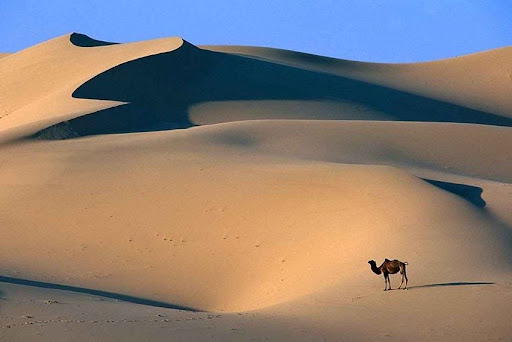Located in Sevrei and Bayandalai soums of Ömnögovi province, the Khongoryn Els sand dunes stretch approximately 180 kilometers behind the Sevrei and Zuulun mountain ranges. Extending from the northwest to the southeast, the dunes cover a total area of about 965 square kilometers. The widest part in the northwest spans 27 kilometers, while the narrowest section in the middle measures only 800 meters. From the crest of the dunes, countless ridges can be seen stretching out into the distance.
The surrounding landscape is breathtaking: to the south, rugged mountains rise; in the middle, the endless sand dunes leave no space for vegetation; and to the north, a river flows through a lush green oasis. Seasonal floodwaters descending from the Zuulun Mountains carve a path through the dunes, seeping into the ground and reemerging in the form of springs called Seruun Bulag and Arganga Bulag. These springs form a stream known as the “Khongoryn Gol” (Khongor River), which flows for more than 10 kilometers along the northern edge of the dunes.

Khongoryn Els – The Singing Dunes of Mongolia
Behind Khongoryn Els, several tourist camps are located, offering camel and horseback tours to reach the dunes. On windy days, sandstorms may arise, reducing visibility to almost nothing, which is why the camps are spread out at distances ranging from 5 to 17 kilometers. On calm, sunny days, Khongoryn Els glistens like a golden sea poured out across the land, resembling scattered treasure—truly a magnificent sight.
While exploring the dunes, it is best to begin from the nearest hill, climbing along the sides. Traversing the ridgelines between dune peaks makes the journey easier. Because the sand is loose and constantly shifting, climbing straight up is difficult, and one’s feet quickly sink, making it an exhausting endeavor. In ancient times, the saxaul trees in the Khongoryn Els area grew extremely tall and densely packed. Elders from the region recall stories of how people used to lose sight of their camels among the thickets of saxaul.
On the rocky outcrops of Sevrei Mountain, there are numerous petroglyphs. One notable carving depicts four mounted hunters chasing five ibex, using bows with a simple form, which researchers believe may date back to the Bronze Age.
Duut Mankhan – The Singing Dune
The highest part of Khongoryn Els is called Duut Mankhan, meaning “The Singing Dune.” Taller than a 9-story building, this majestic dune offers breathtaking views from its summit—where even the sound of wind-blown objects or distant animals can be heard clearly. Looking down from the peak, vehicles below appear as tiny specks, like insects. Lying on the sand, one can hear a low humming noise, like an aircraft passing overhead. But as you wait to spot the plane, none appears—the sound is actually the hum created by sand grains sliding gently down the sun-warmed slopes with the wind. This natural resonance is what earned the dune its name: The Singing Dune.
The Legend of Khongoryn Els, Hatan Sevrei, and Toli Khad
Locals tell a famous legend involving four key landmarks near Sevrei and neighboring Noyon soums: Toli Khad, Noyon Bogd Mountain, Hatan Sevrei, and Khongoryn Els.
Long ago, a powerful local lord decided to banish his famously temperamental wife, Sevrei, to a distant land upon the advice of one of his advisors. Angry and sorrowful, Lady Sevrei threw her mirror during her journey into exile. The shattered pieces are said to have formed Toli Khad—the “Mirror Rock.” Despite her difficult nature, the lord missed her dearly. He would visit Toli Khad to gaze upon his wife’s reflection, and eventually settled nearby, giving rise to what is now called Noyon Mountain (“The Lord”).
While living in exile, Lady Sevrei would sit beside a river every day, brushing her long black hair and lost in sorrow. Among the soldiers guarding her was a man named Khongor, who fell deeply in love with the grieving lady. Though he pleaded with her to begin a new life together, Lady Sevrei refused and instead spent her days in melancholy song.
As the years passed, Toli Khad faded in color, and Khongor, heartbroken and unable to win her love, began placing stones along her path to ease her steps to the river. Over time, those stones became the soft dunes of Khongoryn Els.
Because Lady Sevrei was believed to bless and protect women, locals began referring to the mountain near her exile as Hatan Sevrei—meaning “Queen Sevrei”—and hold it in spiritual reverence to this day.